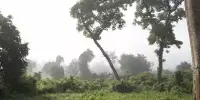A new species of frog known as the “Golden Frog” (Conduct Rockies) was recently discovered in Tanzania. This species of frog is unique because it lacks the ability to produce vocalizations, which is a rare characteristic among frogs. This discovery expands the diversity of amphibians in the region and adds to the growing body of knowledge about these fascinating creatures.
In Africa, scientists discovered a new species of frog with an unusual trait: it is completely silent. The Ukaguru spiny-throated reed frog makes no croaking, singing, or ribbiting sounds. Hyperolius ukaguruensis, named after the Ukaguru Mountains in Tanzania, is one of the few frogs on the planet that does not vocalize to other frogs.
The new species is a member of the “spiny throated” reed frogs, which have tiny spines on the male’s throat. Because they can’t use sound to identify members of their species, they may rely on spines instead.
“It’s a very strange group of frogs,” said Lucinda Lawson, a conservation biologist and research assistant professor at the University of Cincinnati. “Male frogs do not make the typical frog call. We believe they may use the spine as a form of Braille for species identification” Lawson stated. “Without a call, they need to recognize each other in some other way.”
This frog group contains only a few species that live in small populations, making them rare and endangered. Finding a new member of this group is a huge win for conservation, according to Lawson. The finding was published in the journal PLOS ONE.
It’s a very strange group of frogs. Male frogs do not make the typical frog call. We believe they may use the spine as a form of Braille for species identification. Without a call, they need to recognize each other in some other way.
Lucinda Lawson
Lawson led an international team on an amphibian search in the Ukaguru Mountains in 2019, where scientists had previously conducted at least seven surveys. They were hoping to spot the beautiful tree toad, Churamiti maridadi, an amphibian that has only been seen in the wild twice in this forest and is thought to be extinct. “Our expectations were low. We were well aware that the odds were stacked against us” H. Christoph Liedtke, a postdoctoral researcher with the Spanish National Research Council, is one of the study’s co-authors.
Researchers scoured undisturbed streambanks both day and night, using handheld global-positioning satellite receivers to track their progress. They investigated under logs and in tree holes in a forest area frequented by beekeepers, poachers, and small-scale loggers. They also set pitfall traps made of plastic buckets buried at ground level to catch amphibians hiding beneath the leaf litter. Researchers consulted with local foresters and distributed photos of the toad to nearby residents in the hopes that someone – anyone – had seen it.
While the toad was never found, researchers discovered a previously unknown population of reed frogs. “The time spent looking for the lovely tree toad produced unexpected results. It was a fantastic discovery that made the effort worthwhile” Liedtke explained.

The newly discovered reed frog joins the Hyperolius genus, which contains nearly 200 species. According to Lawson, they immediately recognized they had discovered something special. “With any Hyperolius, I can probably tell whether it’s new or potentially new just by looking at it,” Lawson said. “It was immediately obvious that it was a spiny-throated reed frog. However, instead of the green color found in the other species, this one was a golden, greenish brown” Lawson stated. “Color variation doesn’t always mean anything, but it might here.”
A combination of genetic and genomic analyses confirmed the frog’s uniqueness among Hyperolius species. Researchers also identified its closest evolutionary relative, Hyperolius ruvuensis, a critically endangered and likely extinct species.
The frog has unusual body proportions, with smaller eyes in relation to its head than other spiny-throated reed frogs, according to measurements. According to Lawson, describing a species is the first step toward protecting it, especially in increasingly fragmented forests like the Ukaguru Mountains.
According to the study, the newly discovered frog could be of high conservation concern. “The Mamiwa-Kisara North Forest Reserve is a T-shaped remnant forest,” Lawson said. “It has a lot of edge effects from people cutting firewood. There are all sorts of pressures on this forest. It’s easy to cross the whole thing in just a few hours of hiking.”
Knowing how many species exist and where is critical to conservation, Liedtke said. “The Ukaguru Mountains are part of the greater Eastern Arc Rift, a fascinating cradle of biodiversity, with many species endemic to single mountain blocks,” Liedtke said. “The fast population growth in Tanzania means that the mountain forest habitats are under growing threats from people.”
Amphibians are particularly vulnerable to human impacts. They are vulnerable to toxins or changes in water acidity because they absorb chemicals through their skin. “When a bird’s habitat is destroyed, it may be able to fly to a new forest. However, amphibians find this difficult “Lawson stated. Lawson believes that having a diverse range of species is essential for maintaining healthy ecosystems. “We give this question a lot of thought: why does one species matter?” Lawson stated.
Frogs are a component of the food chain. They eat insects, which are then eaten by other animals. “Nothing happens if this one species goes extinct. We have only lost one more strand in the ecosystem’s fabric” Lawson stated. “But if you keep pulling out strands, the ecosystem becomes destabilized and the fabric unravels.”
Co-author Simon Loader, curator of vertebrates at London’s Natural History Museum, expressed delight at the opportunity to contribute to the description of a new species. The discovery demonstrates how much more there is to learn about the world’s diverse regions.
“We still have a long way to go before we know what species exist and where they can be found,” he said. “This is especially true for Tanzania’s biodiverse submontane forests.”
















